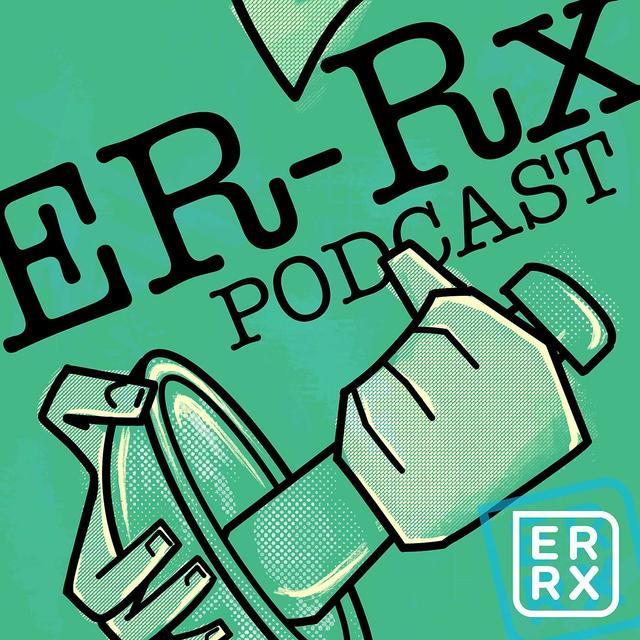Hello and welcome to Episode 37 of ER-Rx. This week, we review the brand-new recommendations from the CDC on how to treat gonorrhea. We’ll discuss the key changes from previous guidelines and we’ll also discuss why these changes were necessary.
Since 2010, the CDC recommended a single 250 mg IM dose of ceftriaxone plus a 1 g dose of oral azithromycin for uncomplicated gonococcal infections. This strategy of dual treatment was used in an attempt to prevent ceftriaxone resistance and to treat possible coinfection with chlamydia. However, the growing pressure to practice antimicrobial stewardship, the low incidence of gonorrhea resistance to ceftriaxone, and the increasing rates of azithromycin resistance overall led to specific changes to the CDC’s recommendations.
Most importantly, the CDC largely does away with azithromycin. Surveillance studies have shown that patients receiving oral azithromycin had significant changes to their gut microbiome, and azithromycin resistance has already been demonstrated in shigella, campylobacter, and some other bugs. Also, evidence even shows decreasing efficacy of azithromycin to treat chlamydial infections.
In addition to the problems that come with routine azithromycin use, data has shown that ceftriaxone MICs to gonorrhea were not increasing as rapidly as we were expecting- and although using dual therapy may have contributed to this, the harmful effects of giving unnecessary azithromycin may outweigh this benefit.
Another big change in the guidelines is that they now recommend higher ceftriaxone doses. Taking into consideration ceftriaxone’s pharmacokinetics and some advanced Monte Carlo simulation, the authors found that a 250 mg dose didn’t consistently achieve high enough concentrations for a long enough period of time to adequately treat gonorrhea. The dose that seemed to work best was 5 mg/kg, which means an average 80-100 kg patient should receive a 500 mg dose, and patients weighing more naturally requiring a higher dose.
Another reason for the higher ceftriaxone dosing comes from the fact that pharyngeal gonorrhea requires higher ceftriaxone concentrations that can best be achieved with doses greater than 250 mg. Interestingly many countries had already been recommending higher ceftriaxone dosing for quite some time.
The final recommendations are, in the setting of known uncomplicated gonorrhea of the cervix, urethra, or rectum, a single 500 mg IM dose of ceftriaxone is now recommended. Patients weighing > 150 kg should receive a 1 g dose.
For empiric treatment or if chlamydia is suspected, doxycycline 100 mg twice daily for 7 days is recommended in addition to the ceftriaxone, replacing azithromycin. But in the setting of pregnancy, they still recommend the old 1 gram slam of azithromycin since tetracyclines are contraindicated in pregnant patients.
If your patient has a severe cephalosporin or penicillin allergy, we can still use the previous regimen of 240 mg IM gentamicin plus 2 grams of oral azithromycin. And I would recommend an anti-emetic along with this high azithromycin dose.
In the setting of uncomplicated pharyngeal gonorrhea, the guidelines recommend the same ceftriaxone dosing of 500 mg (or 1 g) IM plus doxycycline 100 mg twice daily for 7 days if chlamydia has not been ruled out, once again using azithromycin only in pregnant patients. In the setting of allergies, in pharyngeal gonorrhea we don’t have any other reliable alternatives such as gentamicin plus azithromycin, so thoroughly assessing reported allergies or consulting an ID specialist for treatment options is recommended.
A test of cure after 7-14 days is only recommended for pharyngeal gonorrhea. Also, all patients treated for gonorrhea in general should be retested 3 months after treatment.
At my site, the ER pharmacists run a culture call-back service, where any lab or culture that results after the patient discharges from the ER goes to a Pharmacy In-Basket. A lot of the calls we make are for STI results. Our state law allows for expedited partner therapy, where we can also treat the patient’s partner without them being seen. In this setting, the CDC recommends treatment of the partner with a single 800 mg oral dose of cefixime plus doxycycline 100 mg twice daily for 7 days if chlamydia has not been excluded.
But this is where I slightly disagree. By 2011, the MICs of cefixime necessary to inhibit gonorrhea were growing, and by 2012 cefixime was no longer recommended as a treatment option. Cefixime just isn’t as effective as IM ceftriaxone, especially in the setting of pharyngeal gonorrhea. This is evidenced by the fact that they even increased the dose from 400 mg historically, to the 800 mg dose to try to make up for this.
So at my site, we typically offer expedited partner therapy for chlamydia only. But if the index patient was positive for gonorrhea, or both gonorrhea and chlamydia, we recommend the patients partner or partners be seen for appropriate treatment with IM ceftriaxone as well.
In conclusion, the guidelines changed because gonorrhea remains highly sensitive to ceftriaxone, azithromycin resistance is increasing, and we are all on the antimicrobial stewardship train. We personally haven’t made formal changes to our practice until we discuss with the ID team and our Department of Health.
Some questions remain: can azithromycin still be used instead of doxycycline in patients who will be noncompliant with a 7-day course of antibiotics? Should we be more liberal in offering oral cefixime for expedited partner therapy? Stay tuned for some answers in the future.
As always, thank you so much for your time. Remember that there’s still time to enter the drawing for a medically-related prize through the podcast. Just sign up for our newsletter on errxpodcast.com. The winner will be announced in the upcoming weeks.

